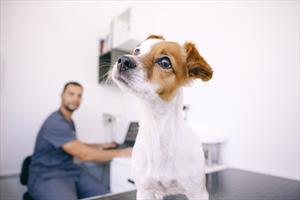Dog at vet

Photo courtesy of Adobe
A pet’s mental health is as important as physical health, which is why it may not be possible for your pet’s veterinarian to complete an examination or treatments when you bring your pet in. If your pet is showing significant levels of FAS (fear, anxiety and stress), your veterinarian may give you medication to be given before your pet’s next appointment.
Why does my pet need this medication?
High levels of FAS can have negative effects in many ways. It isn’t healthy for your pet. Elevated stress hormone levels can suppress the immune system, change lab work results, and over the long term may even shorten your pet’s life.
Every time your pet is in a stressful situation such as going to the veterinarian, they learn to associate it with feeling anxious or scared. That means that each time they go back to the clinic or a groomer, or you try to do something that they find scary, they get more and more scared. They also anticipate something bad happening, so the anxiety starts sooner and sooner.
If they stay at a high level of FAS, your pet may learn that the only way to make people stop doing the things that scare them is to be aggressive. This adaptation could result in a situation where your pet is sick or injured and making sedation risky but necessary because of aggression due to repeated negative experiences. This risk can limit your veterinarian’s ability to provide necessary medical care to your pet.
My pet isn’t aggressive, can’t you just do what they need?
Physically we might be able to do these things, but it would have a negative impact on your pet’s mental health. We don’t want them to learn to be more afraid at the vet’s office or start being afraid of strangers or you or in other situations.
He didn’t need medication last time, why are you saying he needs it now?
FAS often increases because of memories of bad experiences. Giving medication to lower FAS also changes what your pet is learning so they don’t continue to become more and more anxious or aggressive.
What if my pet is still fearful after taking these medications?
The medications you give at home may not be enough for your veterinarian to do full procedures but may allow injectable sedation to be given without causing undue stress. If they don’t need urgent care, you may need to try a different combination of medications or different doses.
What else can we do to lower my pet’s FAS?
Happy visits
If your pet travels in a carrier, use treats so they’re happy about going in and out of the carrier at home and take them for car rides in it so it isn’t a scary thing. Take your pet to the clinic when nothing is needed so they can learn that it’s a good place to be. Start out just giving treats in your car or out in the parking lot. Call ahead; if it’s a quiet time, staff may be able to come out and give your pet treats or have them come inside for some.
Home exams
If your dog or cat is fearful at the veterinarian’s, but is not aggressive or extremely fearful at home, you can get a pulse and respiratory rate and take their temperature at home. You can also take pictures of their teeth in case they need to be muzzled, in which case teeth can’t be examined.
Basket muzzle training for dogs
For the safety of your clinic staff and ultimately of your dog, many fearful dogs require muzzles. If the muzzle is introduced properly, your dog will associate it with treats and good things, so it will lower anxiety when worn. If it is not introduced properly, putting a muzzle on a fearful dog can increase anxiety and aggression. If you want more information about using a basket muzzle visit the Muzzle Project.
Visit a veterinary behaviorist
Often dogs who are highly anxious at veterinary visits are struggling with other anxieties in their day-to-day lives. A veterinary behaviorist can help address your dog’s overall mental health as well as working to lower their anxiety for veterinary visits, grooming, and other types of handling.